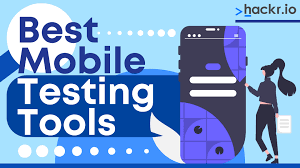With the rise in the development of mobile applications across the world, mobile testing mechanisms have to be tightened and upscaled to keep up with the pace. All the features and functionalities need to be tested thoroughly to ensure there are no bugs and glitches that can cause users to uninstall these applications. Choosing the right mobile testing tool with the right features is a prerequisite for efficient testing. as a wrong tool can lead to a waste of time and resources and negatively impact the software development process.
Let’s check out the top 6 mobile testing tools for enhancing the precision, effectiveness, and scope of your iOS and Android mobile testing.
The Best Mobile Testing Tools for 2023
These mobile testing tools can cut down on the amount of time taken for testing and increase the efficiency of your testing efforts.
- TestGrid
With TestGrid, you can easily perform automated testing of even the most complicated features of mobile applications, whether for iOS, Android, Windows, or any other system. The scriptless automation testing platform has a simple, easy-to-understand interface that even non-programmers can use effectively.
Users can reuse all the tests on the apps’ different versions and even on other apps. It also allows you to remotely conduct numerous tests from anywhere and anytime with only a simple login to a cloud server.
The Benefits of Using TestGrid::
- You can conduct parallel tests on various browsers and devices, saving time and effort for developers and QA teams
- It is a one-stop solution through which you can conduct API testing, cross-browser testing, and other tests without needing any the installation of third-party apps
- It lets you automate test cases using simple keywords
- It provides support for all mobile devices, whether Android, iOS, and Windows
- Users get easy-to-understand documentation and even video presentations of each feature for support
- Ranorex
For testing mobile applications, Ranorex Studio provides a one-stop shop. This powerful testing platform is preferred by organizations for its cross-platform testing capabilities. It offers testing on real devices as well as emulators.
The Benefits and Drawbacks of Using Ranorex:
Pros:
- Ranorex provides an object-identification feature through which you can identify and analyze different types of objects
- Its straightforward user interface with drag-and-drop feature makes it suitable for developers of all skill levels to create and manage tests.
- You can integrate it with other tools like TestRail or TestSell for test management
- It generates comprehensive reports that speed up the process of finding and fixing faults.
- You can integrate it with Azure DevOps and Jenkins for build and release management
Cons:
- Since Ranorex is a licensed tool, it might not be feasible for low-budget groups to use it.
- It supports only two scripting languages, VB.NET, and C#
- EarlGrey
With capabilities like synchronization, user-check interaction, and visibility checks, EarlGrey is a testing framework for iOS mobile apps that Google created. Due to its synchronization feature, many users prefer this tool as it enables monitoring the various sources and states that may have an impact on the performance of the app., such as the user interface (UI) of the software, network issues, and anything else that can be resolved immediately.
EarlGrey’s Benefits and Drawbacks:
Pros:
- You can use it to test different iOS devices
- Native & hybrid mobile app testing is supported.
- It provides access to many real iOS devices for accurate app testing
- It lets you debug your apps instantly with video recordings and instrumentation logs
Cons:
- EarlGrey’s can only be used to test iOS apps.
- Some more complex aspects of testing mobile apps, like animations, are not fully supported.
- It takes skill to properly configure and set up EarlGrey.
- Complex application testing may prove difficult using EarlGrey.
- MonkeyTalk
MonkeyTalk is a framework for automated testing of iOS and Android applications. The technology allows us to use code we’ve already created for iOS on Android apps. MonkeyTalk is ideal for novices because of its simple-to-understand scripts. Also, we can create reports in XML and HTML, and the tool supports testing on both real devices and emulators.
Benefits and drawbacks of MonkeyTalk:
Pros:
- MonkeyTalk is a free, open-source solution for the automated testing of iOS and Android mobile apps
- It doesn’t require any programming knowledge to perform tests using MonkeyTalk
- It offers a user-looping concept
- It offers support for Jenkins and Hudson for continuous integration
Cons:
- Testing apps on the most recent devices can be challenging due to MonkeyTalk’s lack of support for upgraded versions of iOS and Android.
- MonkeyRunner
Because it works well for functional and regression testing as well as providing several device controls for Android applications, MonkeyRunner is a highly sought-after testing tool. Python is the ideal language for creating test scripts that can be used to perform functional tests and unit test suites.
In actuality, MonkeyRunner employs Jython, a Java-based Python implementation, to enable interaction between the MonkeyRunner API and the Android framework. It’s interesting to note that this programme has the ability to run tests and contrast the output screenshots with a collection of screenshots that are intended to be accurate.
Benefits and drawbacks of MonkeyRunner:
Pros:
- It is a free-of-charge and open-source mobile app testing application.
- Python, a widely used and accessible programming language, serves as the foundation for MonkeyRunner.
- The MonkeyRunner API lets you apply one or more test suites across different devices or emulators.
- It lets you run automated start-to-finish tests for an Android application
- It can be used to test app stability by comparing output screenshots with screenshots that are believed to be correct
Cons:
- You can run only limited and basic tests using the tool
- It lacks proper documentation support
- You will need to write tests for each device
- TestSigma
The mobile app testing solution from TestSigma offers testing on several Android and iOS versions and is quite flexible. Simple English can be used to write test cases, and artificial intelligence is used to update automated tests. With the help of its cross-platform mobile testing functionality, you can quickly and easily create test scripts in plain English that can be executed on any device, independent of its operating system or browser.
Benefits and drawbacks of TestSigma:
Pros:
- Automate your online and mobile app testing using TestSigma, a cloud-based test automation platform.
- TestSigma is a user-friendly testing tool because it employs NLP (natural language processing) to allow even non-technical people to build test cases.
- It can be easily integrated with other tools like Jira & Jenkins.
- Testsigma’s real-time reporting and analytics features make it easy for development teams to monitor the status of individual test cases & spot problems as they arise.
Cons:
- Its reporting features can be improved
- It doesn’t have a feature that lets you compare two screenshots
Conclusion
These top mobile automation testing tools all have unique features and advantages. Select a tool that aligns well with your project’s requirements and one that offers different testing capabilities in one solution.
Many organizations prefer using a scriptless automation testing platform like TestGrid for their end-to-end testing needs for mobile applications. With TestGrid, you can cost-effectively perform numerous tests in parallel on various devices and browsers, saving time and effort.





